
Honeymoon home
South Africa 1
Botswana
Zimbabwe
South Africa 2
|
Then we headed North. The Defender had a range of 1200km and cruised very happily at 120kph (75mph). We only had one spare tire, the tires were tubeless, and we had no repair kit. I remembered from my earlier experience many desert evenings spent patching buffalo thorn holes in Michelin inner-tubes, so this concerned me. That is, until I checked the tires and noticed that they were 13 ply Generals made in South Africa. Needless to say the spare went unused--as a tire at least.
By early evening we had reached the border and we crossed into Botswana at Tlokweng. At the border we met some Italians in a Land Cruiser who were on a similar trip to ours. I asked them where they planned to stay the night and they gave directions to a camp site.
After changing money we headed into Gaborone. We became immediately aware of the lack of road names. There were plenty of streets, and plenty of poles, but no names on the poles. This created a new navigation problem and proved to be our first taste of a recurring problem in Botswana. Luckily we came across the Italians, again, stopped at the side of the road. Seems that the people who had rented the Land Cruiser before them had hit a donkey on the road in Botswana and the right front hub was seizing up. We followed them to the camp site and offered to follow them back in to town the next morning to visit the Toyota dealer. That evening we traded stories about Africa. Several years earlier they had tripped across the Namib desert and were now back to do the Kalahari. It was here that we learned that the game parks in Botswana now require camping permits at reserved sites, rather than the free-for-all I recalled from fifteen years ago.
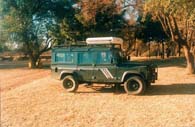 |
 |
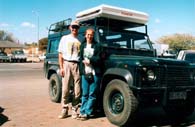 |
| Stopping at Lions Camp for the night. |
Our Italian friends. |
At the Toyota dealership. |
After dropping the Land Cruiser off at the dealership the next morning, we took the Italians and headed for the Parks office to make reservations. My plan up to this point had been to follow a similar route to what I had done before. That is to head out of Gaborone to the North East to Serowe, then to Orapa past Mopipi Pan and Lake Xau to Rakops. From there I wanted to go into the Makgadikgadi Pan Reserve and on to Maun and Moremi Wildlife Reserve. Moremi, being in the Okavango Delta, would require a long stay. This route skirted the Central Kalahari to the East and North. Unfortunately, at the Parks Office we were told that there were no camp sites available in Moremi for the rest of the month!! Likewise with Chobe, our main destination after Moremi. Makgadikgadi Pan and the Central Kalahari Game Reserve were also booked up. So, we checked the map and decided on a different plan of attack. Instead of heading North we would head South West to Gemsbok National Park and then from there head North through the Kalahari to Maun and the Okavango. I still wanted to go to Moremi, so we decided we'd just wing it and hope for a cancellation when we got there. This route was much more off the beaten path and involved much more off-road driving, both of which were fine with us. So we reserved six days at the Mabuasehube Game Reserve on the desolate East side of Gemsbok National Park. The Italians confirmed reservations for Makgadikgadi Pan and Central Kalahari Game Reserve, but, like us, were unable to get in to Moremi and Chobe. If the number of Game Parks seems confusing, don't worry, it is! A full 19% of the land in Botswana is taken up by National Parks.
By this time it was close to lunch. The bureaucracy you have to wade through in African countries is nothing if not impressive! The Toyota was still not fixed, but we decided we had to leave. The Italians took the only picture of both of us we have from the honeymoon! We said our good-byes and hit the road. As a side note, not long ago I got an email from one of the Italians detailing all the car trouble they had on their trip. Including a broken radiator and a leaking battery in the middle of the desert. They got a replacement Land Cruiser from the rental company and that blew the fuel pump just outside the Toyota dealership in Maun! But on to our story. . .
The route we followed all afternoon was on paved roads, and was uneventful except for the odd cow in the road. We passed through Kanye, Jwaneng and Khakhea by evening. The Kalahari is a scrub desert, not a sandy desert like the Namib. All around us for as far as the eye could see was yellow grass and the occasional mopane tree. We pulled off the road on a sandy track to camp. Sitting on the roof rack in the evening, the silence and sheer expanse of the wilderness was impressive!
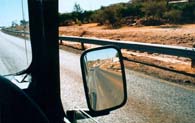 |
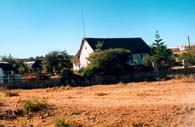 |
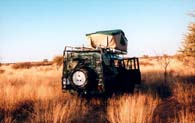 |
| The long road west. |
Views along the road. |
Camping off the road. |
Early the next morning we made it to Werda and then to the turn off to Mabuasehube. We were now on single track in soft and deeply rutted sand heading North towards our only land mark, Goa Village, and the going was much slower. Just off the main road we had to pull over for a kid in a Toyota coming the other way, but his proved to be the last car we would see on the road all day! In several places we had to drop into low range to get through soft sand and then switch up to high on the move (a technique that would prove useful on many more occasions.) In several places we would top a raise and see the road disappearing to the horizon in a straight line! It seemed to go on forever! At Goa village the road suddenly blossomed into many tracks, none with a sign. We chose one and chose wrong; it ended at a fence. The village itself was deserted. We went back and chose again, this time picking direction by the sun. We reached a pan with a herd of cattle on it and two indistinct tracks crossing it. Again we chose by the sun and crossed the pan. We wouldn't know we chose the right track until we reached the perimeter of the park four hours later! We saw one car in the afternoon; another 110 off the road with what looked like a work crew. For lunch we just stopped in the road under a tree.
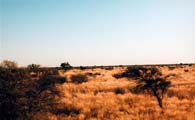 |
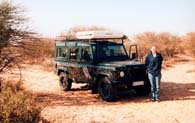 |
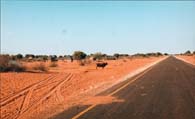 |
| View of the Kalahari. |
Exploring a side track. |
Werda. |
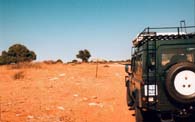 |
 |
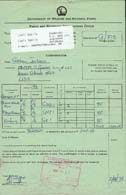 |
| Turn off for Mabuasehube. |
Long trail to the park. |
Camping permit. |
 |
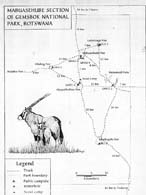 |
 |
| Entry permit. |
Park map. |
This park is remote! |
The perimeter of the park was marked by a sign and a road, but no fence. The sign gave instructions to check in at the scout camp 13km further on. Here the sand was really soft and deep. Mabuasehube is a very dry area, and the main attraction of the Park are several pans with small water holes. We saw gemsbok and ostrich before we checked in at the scout camp. When we paid, the park ranger told us there were three other vehicles in the entire park! We made camp at Mabuasehube Pan and settled in for a wonderful stay. The silence was so complete that Connie became really unnerved. We spent several evenings laying in the tent with the door open watching wildlife on the pans through the binoculars by moonlight! It was magical. One night we had a jackal visit us at dinner time, no doubt attracted by the smell of bacon. We discovered that the bacon was bad, and the Jackal ended up getting it. We camped for two nights at Mabuasehube pan, and during the day visited all of the other pans. Wildlife was not all that abundant. We saw many gemsbok, ostrich, impala and a few wildebeast. Jackals and vultures were also easy to find. Connie discovered that living in the desert involves being dirty most of the time. She threatened to rebel, and so we went to the Scout camp and used their (ice cold) shower.
 |
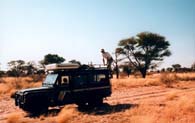 |
 |
| We reach the park boundary. |
Stopping for wood. |
A startled gemsbok. |
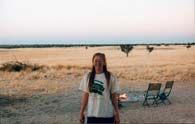 |
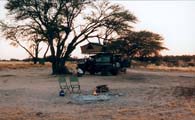 |
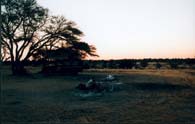 |
| Home sweet home! |
First camp on the pan. |
A very quiet place. |
On the third night we moved our camp to Mpoathutlwa pan. At this point we were getting a little low on diesel, and we decided to cut our stay short and head north in the morning to Maun. Early in the morning we broke camp and, driving out, discovered lion tracks on the road not 20 feet from where we were camped! When we checked out at the scout camp we were told that the lions had come by just before dark the previous evening which would have put them at our camp just after dark. We never saw them, though.
 |
 |
 |
| Mpoathutlwa pan. |
Cleaning up after lunch. |
View over the pan. |
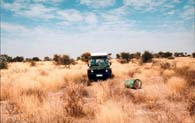 |
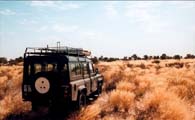 |
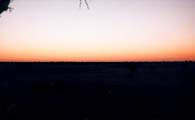 |
| Exploring the end of the road. |
Where the road ends! |
Sunset over the pans. |
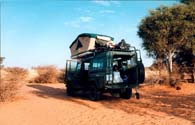 |
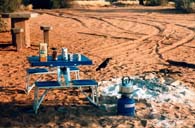 |
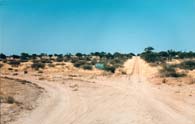 |
| Last camp. |
Having lunch. |
The road out. |
The drive north out of the park was long and very dusty. In many places the ruts were deep enough that I didn't need to steer. We got fuel at Hutkuntsi and picked up paved road and then headed for Ghanzi. At Ghanzi the paved road turned to graded dirt and we discovered several hundred kilometers of severe washboard. It was a bone jarring, tooth loosening ride of the sort that Africa is legendary for. The 110 didn't skip a beat. It was a long day driving, but we finally came to Maun with its glimmering cooking fires and thick smell of smoke. I remembered some of the names from my childhood visits--Riley's Hotel (which is now a Best Western) and Crocodile Camp. Riley's was full, so we stayed at the Sedia Hotel a beautiful old building left over from the colonial days. This was the Africa I remembered--sitting by the pool drinking gin and tonics while to sun set!
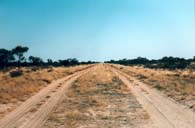 |
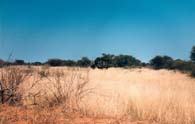 |
 |
| Dual carrigeway! |
Ostriches. |
Pausing for supplies. |
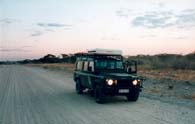 |
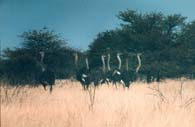 |
 |
| Unpaved section north of Ghanzi. |
More ostriches. |
Fading light as we go north. |
The next morning we picked up supplies and went to the Parks Board office to try to get a camp site in Moremi. Again, we had no luck. They were still booked solid. The only thing we could do was to stay in Maun and drive the 70km in to the park every day. Unfortunately this eliminated the two best game viewing times for us -- early morning and evening. I had been looking forward to spending some quiet evenings in the park watching cats and other predators. But we had to live with what we had. We left Maun and headed north to the park, crossing the veterinary cordon fence on the way. At the fence, the road became very soft and sandy. Moremi is listed as 4-wheel-drive access only, and in some places this is very true. The first day in the park, we saw an amazing profusion of wildlife, but still no cats! The park was far more crowded than I remembered, and we had to compete with many other vehicles for space. In some places it was obvious that the big military trucks (including 101 Forward Controls) that the tour companies use were not restricted to the tracks. Especially in the swampy areas vehicle tracks went off in all sorts of directions, and made a real mess of the landscape. Apart from that, though, Moremi is the most amazing place I have seen, and driving around the park is great fun if you like 4-wheeling. In many places the swamp intrudes on the road, and there are a lot of water crossings of indeterminate depth. I was glad we had a diesel, because I didn't relish the thought of getting out of the vehicle in deep water and meeting a crocodile!
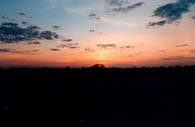 |
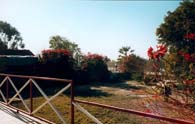 |
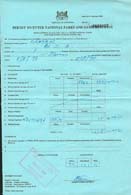 |
| Sunset before we reached Maun. |
Sedia hotel. |
Entry permit for Moremi. |
 |
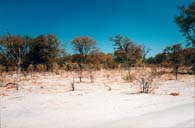 |
 |
| Into the park. |
Looking out for wildlife. |
Connie luxuriating. |
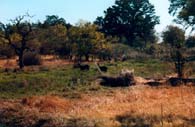 |
 |
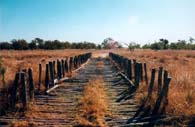 |
| Waterbuck. |
Lechwe. |
4th Bridge. |
 |
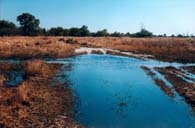 |
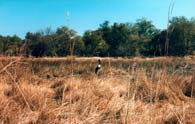 |
| Hippo out of water. |
The road gets wet. |
Stork keeping watch. |
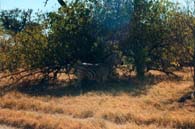 |
 |
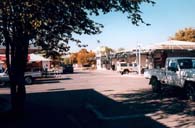 |
| Zebra in the shade. |
D-110 and the bridge. |
In Maun. |
 |
 |
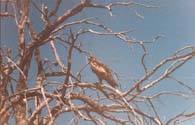 |
| South Gate. |
Large tracks on the road. |
Keeping watch. |
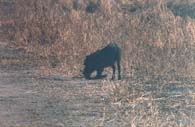 |
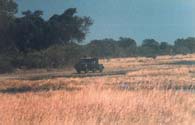 |
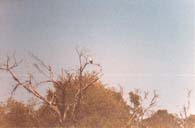 |
| Warthog scrounging. |
Tour truck. |
Fish eagle. |
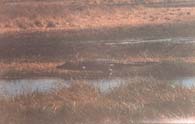 |
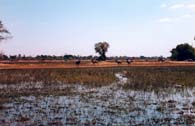 |
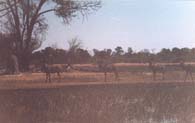 |
| Large croc. |
Kudu. |
The same kudu, harder to see. |
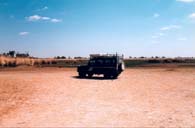 |
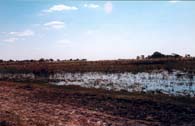 |
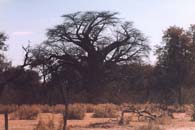 |
| Stopping for lunch by a water hole |
Water by the road |
Impressive bayobab |
It was on our second day in Moremi that we finally saw lions. Connie had begun to believe that wild cats did not really exist and that the park rangers went out at night with special boots to make paw prints to fool the tourists. We came across a pride on Paradise Island, lying under a tree sunning themselves. Later that same day as we crossed Dead Tree Island, I wanted to get a picture of the 110 crossing some deep water. We found a good spot, and the plan was to drive through, drop Connie off with the camera and I would drive back and return. We went through, and Connie was about to get out of the car when she spotted a lone lioness lying under a tree not 10 meters away! We scratched the picture taking idea and turned the camera on the lioness.
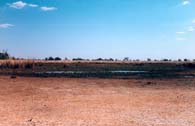 |
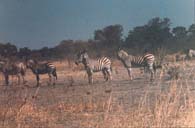 |
 |
| Same water hole, easier to see |
Zebra. |
Large termite mound |
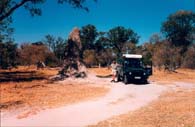 |
 |
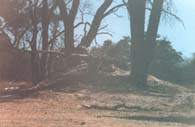 |
| Larger than the 110! |
Track through the water |
There is a lion in this pic |
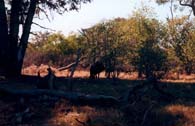 |
 |
 |
| Lone wildebeest |
Crossing 4th Bridge |
We'd see an amazing kill here 6 years later! |
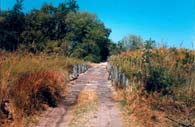 |
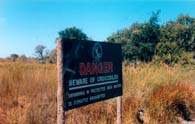 |
 |
| 3rd Bridge |
Warning to live by |
Connie collecting sand |
 |
 |
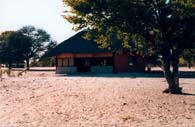 |
| This is desert |
Another bridge |
Basket co-op outside Maun |
In all we spent three days touring Moremi. It was a fantastic experience except for the long drive in and out every day. But we did stay at several nice hotels in Maun, including Riley's and Crocodile Camp. The beds at Crocodile Camp were by far the most comfortable I have ever not slept in. Neither Connie or I could get to sleep that night, for some reason.
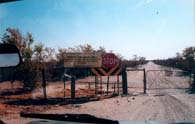 |
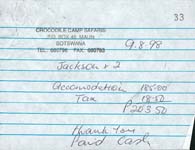 |
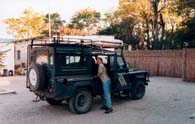 |
| Vet fence |
Croc Camp receipt |
Checking supplies at Croc Camp |
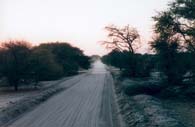 |
 |
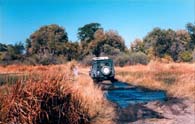 |
| The road into Moremi |
Typical Moremi scene |
Graham having fun in the water |
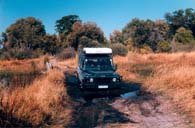 |
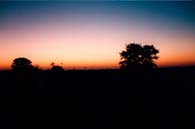 |
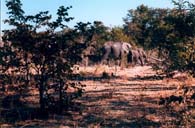 |
| Both ways |
Sunset over Moremi |
Elephants |
On our last day in Moremi, we did the South West side of the park in a long slow tour, and by evening we left by North Gate. Now I had thought that we could find accommodation at North Gate. I knew we couldn't camp because North Gate Camp was all booked up, but there were three lodges listed on the map in the no-mans-land between Moremi and Chobe parks and it seemed likely that we could find something. So with night fast approaching we stopped at Tsaro Lodge and were told they were full. We went on to Kwai River Lodge, but no one was there. The table in the lodge was set for dinner, and there were drinks around, elephants were playing in the watering hole, but not a soul was there. It was pretty spooky. We went on to Machaba Camp and there were people there. After a fifteen minute wait a lady came to help us. She said we could get a room, but it would cost us US$500 each for the night!! She told us that all of the other lodges would be the same. They cater to rich guests who fly in on their private airstrip and get private game tours--and get fleeced in the process. She told us that camping in the area was forbidden because it's all private property, but confidentially she would recommend it as long as we weren't caught! So, given that great advice we went off into the bush to find a spot. We had no idea what the penalty would be if we got caught, so it was a tense night not helped by the elephant herd that spent the night around the 110 munching loudly and trumpeting now and again.
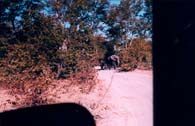 |
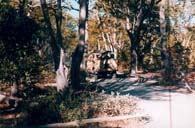 |
 |
| Elephants on the road |
An FC101 tour truck |
More zebra |
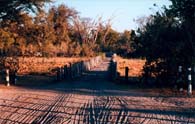 |
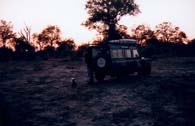 |
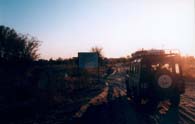 |
| North Gate and out |
Camping outside the park |
Entering Chobe early in the morning |
We got up early and broke camp soon after the sun rose. We both felt much better when we were back on the road headed for the Chobe gate. Chobe is more arid than Moremi since it is not part of the Okavango Delta. Since we had no camping permit for the park we could only get a day transit permit. The plan was to cross the park and exit into Zimbabwe close to Victoria Falls. Little did we realize how long that would take. Given that all of the signs in the park had been vandalized we had an interesting time navigating. In the end Connie navigated by the sun and the odd landmark. It worked well, though we were never really sure where we were. The road was single track, deeply rutted and very soft. We didn't see any other traffic on it all day. Well, that is if you don't count the burned out wreck of a Land Rover Series II Forward Control that had obviously been abandoned long ago. We didn't see much wildlife crossing Chobe. One elephant herd, a few warthog, zebra, wildebeest and lots of dust. The road was rough in spots, sandy in others, and really fun to drive. By late afternoon we were still pushing North hoping to catch the highway to Kasane and the border. We came over a sand dune through some acacia trees and suddenly there was a brand new paved road in front of us. We weren't quite sure what to do but figured that it must be the road we wanted. Half an hour later we were out of Chobe and at the border with Zimbabwe.
 |
 |
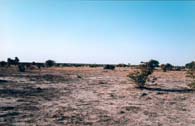 |
| Chobe transit permit |
How far to the staff camp? |
Into Chobe |
 |
 |
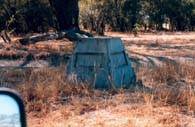 |
| Warthog |
Never identified |
Navigation problems |
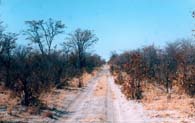 |
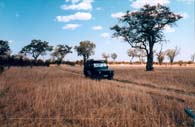 |
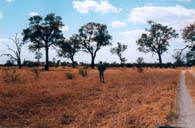 |
| A very long road |
The truck from Graham |
Graham from the truck |
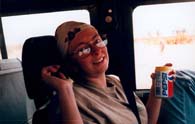 |
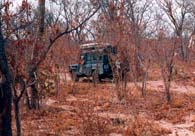 |
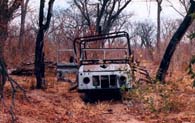 |
| Connie enjoys a taste of home |
Entering Chobe forest |
Abandoned IIB FC |
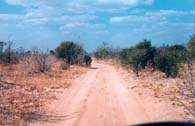 |
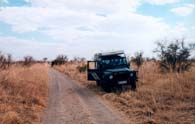 |
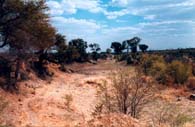 |
| More of that long road |
And more |
Dried watercourse |
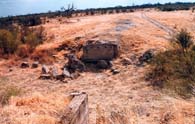 |
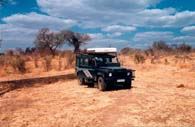 |
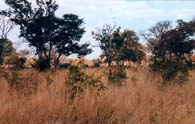 |
| Old bridge |
110 in north Chobe |
Part of the massive Chobe elephant population |
|